Simulation of the Energy Performance of a Building with Green Roofs and Green Walls in a Tropical Climate
Abstract
:1. Introduction
2. Materials and Methods
3. Results and Discussion
- They help in minimizing the building’s cooling and heating needs.
- They delay and decrease stormwater discharge.
- They offer better soundproofing and acoustics management.
- They contribute to capturing and storing CO2 underground.
- They snatch up gaseous and particle contaminants from the ambient air.
- They mitigate the UHI effects.
- They help sustain and increase the life span of plants and animals.
4. Conclusions
- A considerable thermal difference was observed between conventional envelopes and green envelopes.
- Compared to conventional buildings without green envelopes, green walls and roofs decreased the indoor air temperature, radiant temperature, and solar gain by 2.37%, 5.17%, and 73%, respectively.
- Green buildings’ air relative humidity value was about 4.62% higher than that of conventional buildings due to the evapotranspiration of plants.
- The total energy consumption in the selected building was reduced by 10.5%, while the district cooling was reduced by 13% for the selected vegetation thickness.
Author Contributions
Funding
Institutional Review Board Statement
Informed Consent Statement
Data Availability Statement
Acknowledgments
Conflicts of Interest
References
- Manso, M.; Teotónio, I.; Silva, C.M.; Cruz, C.O. Green roof and green wall benefits and costs: A review of the quantitative evidence. Renew. Sustain. Energy Rev. 2020, 135, 110111. [Google Scholar] [CrossRef]
- Benoliel, M.A.; Manso, M.; Ferreira, P.D.; Silva, C.M.; Cruz, C.O. “Greening” and comfort conditions in transport infrastructure systems: Understanding users’ preferences. Build. Environ. 2021, 195, 107759. [Google Scholar] [CrossRef]
- Wang, Q.; Xiao, Y. Has Urban Construction Land Achieved Low-Carbon Sustainable Development? A Case Study of North China Plain, China. Sustainability 2022, 14, 9434. [Google Scholar] [CrossRef]
- Sun, P.; Song, Y.; Lu, W. Effect of Urban Green Space in the Hilly Environment on Physical Activity and Health Outcomes: Mediation Analysis on Multiple Greenery Measures. Land 2022, 11, 612. [Google Scholar] [CrossRef]
- Flores-Larsen, S.; Filippín, C. Energy efficiency, thermal resilience, and health during extreme heat events in low-income housing in Argentina. Energy Build. 2020, 231, 110576. [Google Scholar] [CrossRef]
- Castaldo, V.L.; Pisello, A.L. Uses of dynamic simulation to predict thermal-energy performance of buildings and districts: A review. WIREs Energy Environ. 2017, 7, e269. [Google Scholar] [CrossRef]
- Herath, H.; Halwatura, R.; Jayasinghe, G. Evaluation of green infrastructure effects on tropical Sri Lankan urban context as an urban heat island adaptation strategy. Urban For. Urban Green. 2018, 29, 212–222. [Google Scholar] [CrossRef]
- Besir, A.B.; Cuce, E. Green roofs and facades: A comprehensive review. Renew. Sustain. Energy Rev. 2018, 82, 915–939. [Google Scholar] [CrossRef]
- Verbeke, S.; Audenaert, A. Thermal inertia in buildings: A review of impacts across climate and building use. Renew. Sustain. Energy Rev. 2018, 82, 2300–2318. [Google Scholar] [CrossRef]
- Saaroni, H.; Amorim, J.; Hiemstra, J.; Pearlmutter, D. Urban Green Infrastructure as a tool for urban heat mitigation: Survey of research methodologies and findings across different climatic regions. Urban Clim. 2018, 24, 94–110. [Google Scholar] [CrossRef]
- Perini, K.; Calise, C.; Castellari, P.; Roccotiello, E. Microclimatic and Environmental Improvement in a Mediterranean City through the Regeneration of an Area with Nature-Based Solutions: A Case Study. Sustainability 2022, 14, 5847. [Google Scholar] [CrossRef]
- Wang, K.; Fang, X.; Ma, Y.; Xue, S.; Yin, S. Assessing Effects of Urban Greenery on the Regulation Mechanism of Microclimate and Outdoor Thermal Comfort during Winter in China’s Cold Region. Land 2022, 11, 1442. [Google Scholar] [CrossRef]
- Shooshtarian, S.; Rajagopalan, P.; Sagoo, A. A comprehensive review of thermal adaptive strategies in outdoor spaces. Sustain. Cities Soc. 2018, 41, 647–665. [Google Scholar] [CrossRef]
- Teotónio, I.; Silva, C.M.; Cruz, C.O. Economics of green roofs and green walls: A literature review. Sustain. Cities Soc. 2021, 69, 102781. [Google Scholar] [CrossRef]
- Broto, V.C.; Westman, L.K. Ten years after Copenhagen: Reimagining climate change governance in urban areas. Wiley Interdiscip. Rev. Clim. Chang. 2020, 11, e643. [Google Scholar] [CrossRef] [Green Version]
- Sanchez-Iborra, R.; Bernal-Escobedo, L.; Santa, J. Eco-Efficient Mobility in Smart City Scenarios. Sustainability 2020, 12, 8443. [Google Scholar] [CrossRef]
- Tishkov, S.; Tleppayev, A.; Karginova-Gubinova, V.; Volkov, A.; Shcherbak, A. Citizens’ Behavior as a Driver of Energy Transition and Greening of the Economy in the Russian Arctic: Findings of a Sociological Survey in the Murmansk Region and Karelia. Appl. Sci. 2022, 12, 1460. [Google Scholar] [CrossRef]
- Bockarjova, M.; Botzen, W.; van Schie, M.; Koetse, M. Property price effects of green interventions in cities: A meta-analysis and implications for gentrification. Environ. Sci. Policy 2020, 112, 293–304. [Google Scholar] [CrossRef]
- Zhao, Y.; Xue, J.; Wu, N.; Hill, R.L. An Artificial Oasis in a Deadly Desert: Practices and Enlightenments. Water 2022, 14, 2237. [Google Scholar] [CrossRef]
- Haq, S.M.A.; Islam, M.N.; Siddhanta, A.; Ahmed, K.J.; Chowdhury, M.T.A. Public Perceptions of Urban Green Spaces: Convergences and Divergences. Front. Sustain. Cities 2021, 3, 755313. [Google Scholar] [CrossRef]
- Madureira, H.; Monteiro, A. Going Green and Going Dense: A Systematic Review of Compatibilities and Conflicts in Urban Research. Sustainability 2021, 13, 10643. [Google Scholar] [CrossRef]
- Tang, H.; Liu, J.; Zheng, B. Study on the Green Space Patterns and Microclimate Simulation in Typical Urban Blocks in Central China. Sustainability 2022, 14, 15391. [Google Scholar] [CrossRef]
- United Nations. Home|United Nations. Available online: https://www.un.org/en/ (accessed on 15 November 2022).
- Viecco, M.; Jorquera, H.; Sharma, A.; Bustamante, W.; Fernando, H.J.; Vera, S. Green roofs and green walls layouts for improved urban air quality by mitigating particulate matter. Build. Environ. 2021, 204, 108120. [Google Scholar] [CrossRef]
- Vera, S.; Viecco, M.; Jorquera, H. Effects of biodiversity in green roofs and walls on the capture of fine particulate matter. Urban For. Urban Green. 2021, 63, 127229. [Google Scholar] [CrossRef]
- Borràs, J.G.; Lerma, C.; Mas, A.; Vercher, J.; Gil, E. Energy Efficiency Evaluation of Green Roofs as an Intervention Strategy in Residential Buildings in the Field of Spanish Climate. Buildings 2022, 12, 959. [Google Scholar] [CrossRef]
- Danielski, I.; Svensson, A.; Weimer, K.; Lorentzen, L.; Warne, M. Effects of Green Plants on the Indoor Environment and Wellbeing in Classrooms—A Case Study in a Swedish School. Sustainability 2022, 14, 3777. [Google Scholar] [CrossRef]
- Shao, H.; Kim, G. A Comprehensive Review of Different Types of Green Infrastructure to Mitigate Urban Heat Islands: Progress, Functions, and Benefits. Land 2022, 11, 1792. [Google Scholar] [CrossRef]
- Borysiak, J.; Stępniewska, M. Perception of the Vegetation Cover Pattern Promoting Biodiversity in Urban Parks by Future Greenery Managers. Land 2022, 11, 341. [Google Scholar] [CrossRef]
- Köhler, M.; Kaiser, D. Green Roof Enhancement on Buildings of the University of Applied Sciences in Neubrandenburg (Germany) in Times of Climate Change. Atmosphere 2021, 12, 382. [Google Scholar] [CrossRef]
- Vaezizadeh, F.; Rashidisharifabad, S.; Afhami, R. Investigating the cooling effect of living walls in the sunken courtyards of traditional houses in Yazd. Eur. J. Sustain. Dev. 2016, 5, 27–40. [Google Scholar] [CrossRef]
- Niachou, A.; Papakonstantinou, K.; Santamouris, M.; Tsangrassoulis, A.; Mihalakakou, G. Analysis of the green roof thermal properties and investigation of its energy performance. Energy Build. 2001, 33, 719–729. [Google Scholar] [CrossRef]
- Hui, L.C.; Jim, C.; Tian, Y. Public views on green roofs and green walls in two major Asian cities and implications for promotion policy. Urban For. Urban Green. 2022, 70, 127546. [Google Scholar] [CrossRef]
- Ouyang, W.; Sinsel, T.; Simon, H.; Morakinyo, T.E.; Liu, H.; Ng, E. Evaluating the thermal-radiative performance of ENVI-met model for green infrastructure typologies: Experience from a subtropical climate. Build. Environ. 2022, 207, 108427. [Google Scholar] [CrossRef]
- García, M.; Vera, S.; Rouault, F.; Gironás, J.; Bustamante, W. Cooling potential of greenery systems for a stand-alone retail building under semiarid and humid subtropical climates. Energy Build. 2022, 259, 111897. [Google Scholar] [CrossRef]
- Eumorfopoulou, E.; Kontoleon, K. Experimental approach to the contribution of plant-covered walls to the thermal behaviour of building envelopes. Build. Environ. 2009, 44, 1024–1038. [Google Scholar] [CrossRef]
- Akinwolemiwa, O.H.; de Souza, C.B.; De Luca, L.M.; Gwilliam, J. Building community-driven vertical greening systems for people living on less than £1 a day: A case study in Nigeria. Build. Environ. 2018, 131, 277–287. [Google Scholar] [CrossRef]
- Li, H.; Zhao, Y.; Sützl, B.; Kubilay, A.; Carmeliet, J. Impact of green walls on ventilation and heat removal from street canyons: Coupling of thermal and aerodynamic resistance. Build. Environ. 2022, 214, 108945. [Google Scholar] [CrossRef]
- Zhuang, J.; Qiao, L.; Zhang, X.; Su, Y.; Xia, Y. Effects of Visual Attributes of Flower Borders in Urban Vegetation Landscapes on Aesthetic Preference and Emotional Perception. Int. J. Environ. Res. Public Health 2021, 18, 9318. [Google Scholar] [CrossRef]
- Kent, M.; Schiavon, S. Evaluation of the effect of landscape distance seen in window views on visual satisfaction. Build. Environ. 2020, 183, 107160. [Google Scholar] [CrossRef]
- Tennessen, C.M.; Cimprich, B. Views to nature: Effects on attention. J. Environ. Psychol. 1995, 15, 77–85. [Google Scholar] [CrossRef]
- Tolderlund, L.; Ap, L. Grp Design Guidelines and Maintenance Manual for Green Roofs in the Semi-Arid and Arid West. 2010. Available online: https://www.epa.gov/green-infrastructure/design-guidelines-and-maintenance-manual-green-roofs-semi-arid-and-arid-west (accessed on 29 December 2022).
- Lo, A.Y.; Jim, C.; Cheung, P.K.; Wong, G.K.; Cheung, L.T. Space poverty driving heat stress vulnerability and the adaptive strategy of visiting urban parks. Cities 2022, 127, 103740. [Google Scholar] [CrossRef]
- Hui, L.C.; Jim, C. Urban-greenery demands are affected by perceptions of ecosystem services and disservices, and socio-demographic and environmental-cultural factors. Land Use Policy 2022, 120, 106254. [Google Scholar] [CrossRef]
- Jim, C.; Hui, L.C. Offering green roofs in a compact city: Benefits and landscape preferences of socio-demographic cohorts. Appl. Geogr. 2022, 145, 102733. [Google Scholar] [CrossRef]
- Francis, L.F.M.; Jensen, M.B. Benefits of green roofs: A systematic review of the evidence for three ecosystem services. Urban For. Urban Green. 2017, 28, 167–176. [Google Scholar] [CrossRef]
- Kamarulzaman, N.; Hashim, S.Z.; Hashim, H.; Saleh, A.A. Green Roof Concepts as a Passive Cooling Approach in Tropical Climate- An Overview. E3S Web Conf. 2014, 3, 01028. [Google Scholar] [CrossRef]
- Gomes, Y.R.M.; dos Santos, S.M.; de Macedo, P.M.T. Effects of ecological roofs in water quality: An experimental study over a humid tropical climate. Sustain. Water Resour. Manag. 2023, 9, 17. [Google Scholar] [CrossRef]
- Li, Y.; Liu, J. Green roofs in the humid subtropics: The role of environmental and design factors on stormwater retention and peak reduction. Sci. Total. Environ. 2023, 858, 159710. [Google Scholar] [CrossRef]
- Priya, U.K.; Senthil, R. A review of the impact of the green landscape interventions on the urban microclimate of tropical areas. Build. Environ. 2021, 205, 108190. [Google Scholar] [CrossRef]
- Halwatura, R.; Jayasinghe, M. Strategies for improved micro-climates in high-density residential developments in tropical climates. Energy Sustain. Dev. 2007, 11, 54–65. [Google Scholar] [CrossRef]
- Hien, W.N.; Yok, T.P.; Yu, C. Study of thermal performance of extensive rooftop greenery systems in the tropical climate. Build. Environ. 2007, 42, 25–54. [Google Scholar] [CrossRef]
- Wooster, E.; Fleck, R.; Torpy, F.; Ramp, D.; Irga, P. Urban green roofs promote metropolitan biodiversity: A comparative case study. Build. Environ. 2022, 207, 108458. [Google Scholar] [CrossRef]
- Khotbehsara, E.M.; Daemei, A.B.; Malekjahan, F.A. Simulation study of the eco green roof in order to reduce heat transfer in four different climatic zones. Results Eng. 2019, 2, 100010. [Google Scholar] [CrossRef]
- Balany, F.; Muttil, N.; Muthukumaran, S.; Wong, M.S.; Ng, A.W.M. Studying the Effect of Blue-Green Infrastructure on Microclimate and Human Thermal Comfort in Melbourne’s Central Business District. Sustainability 2022, 14, 9057. [Google Scholar] [CrossRef]
- Shao, B.; Valeo, C.; Mukhopadhyaya, P.; He, J. Influence of Temperature and Moisture Content on Thermal Performance of Green Roof Media. Energies 2021, 14, 2421. [Google Scholar] [CrossRef]
- Kim, S.; Aydin, B.; Kim, S. Simulation Modeling of a Photovoltaic-Green Roof System for Energy Cost Reduction of a Building: Texas Case Study. Energies 2021, 14, 5443. [Google Scholar] [CrossRef]
- Juras, P. Positive Aspects of Green Roof Reducing Energy Consumption in Winter. Energies 2022, 15, 1493. [Google Scholar] [CrossRef]
- Rapisarda, R.; Nocera, F.; Costanzo, V.; Sciuto, G.; Caponetto, R. Hydroponic Green Roof Systems as an Alternative to Traditional Pond and Green Roofs: A Literature Review. Energies 2022, 15, 2190. [Google Scholar] [CrossRef]
- Freewan, A.A.; Jaradat, N.M.; Amaireh, I.A. Optimizing Shading and Thermal Performances of Vertical Green Wall on Buildings in a Hot Arid Region. Buildings 2022, 12, 216. [Google Scholar] [CrossRef]
- Hao, X.; Liu, L.; Tan, H.; Lin, Y.; Hu, J.; Yin, W. The Impacts of Greenery Systems on Indoor Thermal Environments in Transition Seasons: An Experimental Investigation. Buildings 2022, 12, 506. [Google Scholar] [CrossRef]
- Hozhabralsadat, M.S.; Heidari, A.; Karimian, Z.; Farzam, M. Assessment of plant species suitability in green walls based on API, heavy metal accumulation, and particulate matter capture capacity. Environ. Sci. Pollut. Res. 2022, 29, 68564–68581. [Google Scholar] [CrossRef]
- Elaouzy, Y.; El Fadar, A. Energy, economic and environmental benefits of integrating passive design strategies into buildings: A review. Renew. Sustain. Energy Rev. 2022, 167, 112828. [Google Scholar] [CrossRef]
- Nam, S.; Kim, J.; Lee, D. Current Status of Aged Public Buildings and Effect Analysis Prediction of Green Remodeling in South Korea. Sustainability 2021, 13, 6649. [Google Scholar] [CrossRef]
- Teng, J.; Wang, P.; Mu, X.; Wang, W. Energy-saving performance analysis of green technology implications for decision-makers of multi-story buildings. Environ. Dev. Sustain. 2021, 23, 15639–15665. [Google Scholar] [CrossRef]
- Trovato, M.R.; Nocera, F.; Giuffrida, S. Life-Cycle Assessment and Monetary Measurements for the Carbon Footprint Reduction of Public Buildings. Sustainability 2020, 12, 3460. [Google Scholar] [CrossRef] [Green Version]
- Vox, G.; Blanco, I.; Convertino, F.; Schettini, E. Heat transfer reduction in building envelope with green façade system: A year-round balance in Mediterranean climate conditions. Energy Build. 2022, 274, 112439. [Google Scholar] [CrossRef]
- Sekban, D.U.G.; Akyol, D. Contributions of Green Infrastructure-Oriented Planning and Designing in Residential Gardens to the City’s Ecosystem: Case of Trabzon City, Turkey. J. Urban Plan. Dev. 2023, 149, 05022043. [Google Scholar] [CrossRef]
- Zhang, M.; Zhang, F.; Chen, D.; Tan, M.L.; Chan, N.W. Urban local surface temperature prediction using the urban gray-green space landscape and vegetation indices. Build. Environ. 2022, 226, 109723. [Google Scholar] [CrossRef]
- Algarni, S.; Almutairi, K.; Alqahtani, T. Investigating the performance of energy management in office buildings by using a suitable green roof design to reduce the building’s energy consumption. Sustain. Energy Technol. Assessments 2022, 54, 102825. [Google Scholar] [CrossRef]
- Wu, D.; Seibold, S.; Ellwood, M.D.F.; Chu, C. Differential effects of vegetation and climate on termite diversity and damage. J. Appl. Ecol. 2022, 59, 2922–2935. [Google Scholar] [CrossRef]
- Rajagopal, P.; Priya, R.S.; Senthil, R. A review of recent developments in the impact of environmental measures on urban heat island. Sustain. Cities Soc. 2023, 88, 104279. [Google Scholar] [CrossRef]
- Dong, J.; Guo, F.; Lin, M.; Zhang, H.; Zhu, P. Optimization of green infrastructure networks based on potential green roof integration in a high-density urban area—A case study of Beijing, China. Sci. Total. Environ. 2022, 834, 155307. [Google Scholar] [CrossRef] [PubMed]
- Abuseif, M.; Dupre, K.; Michael, R.N. Trees on buildings: Opportunities, challenges, and recommendations. Build. Environ. 2022, 225, 109628. [Google Scholar] [CrossRef]
- Ogut, O.; Tzortzi, N.J.; Bertolin, C. Vertical Green Structures to Establish Sustainable Built Environment: A Systematic Market Review. Sustainability 2022, 14, 12349. [Google Scholar] [CrossRef]


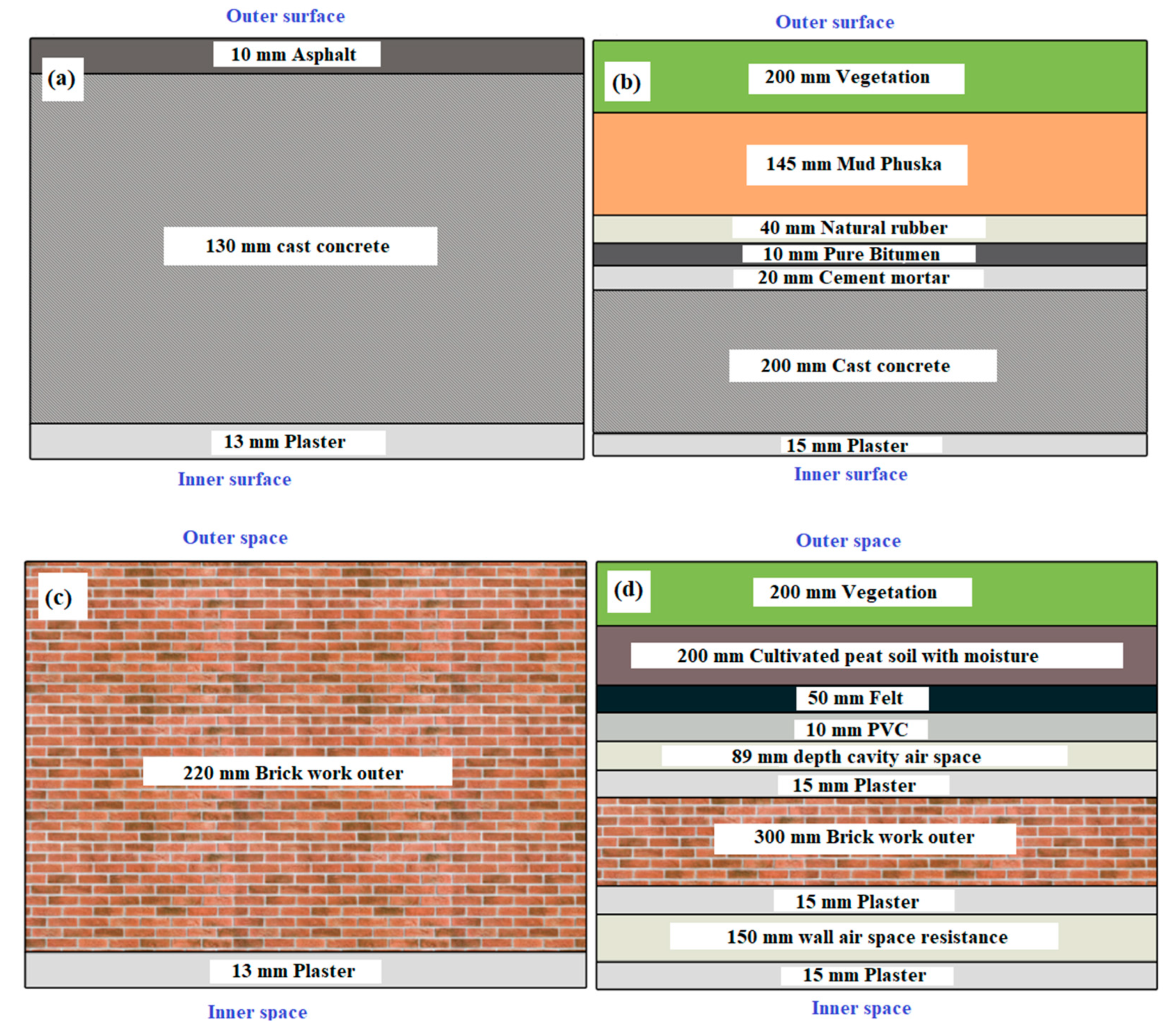
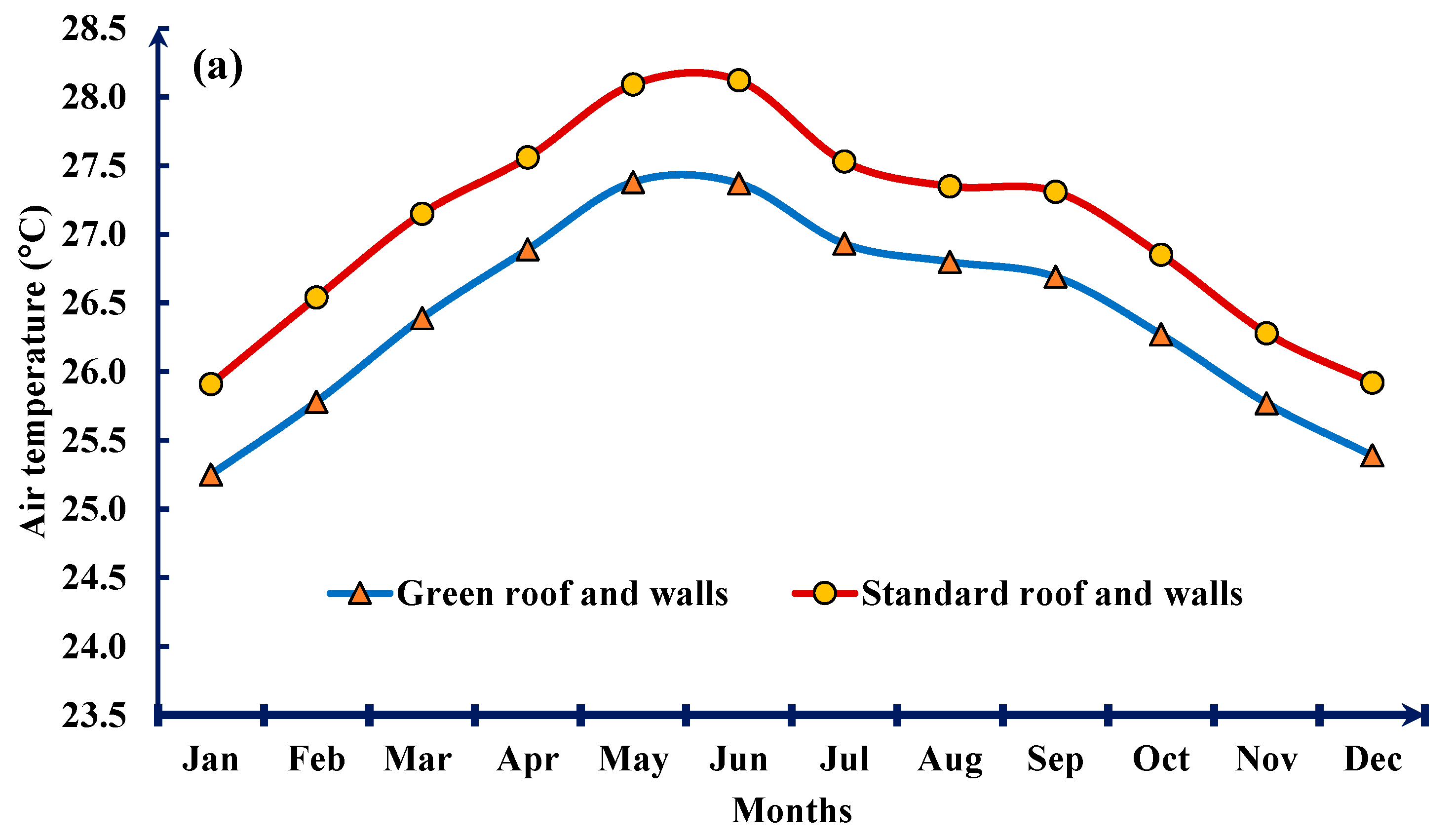
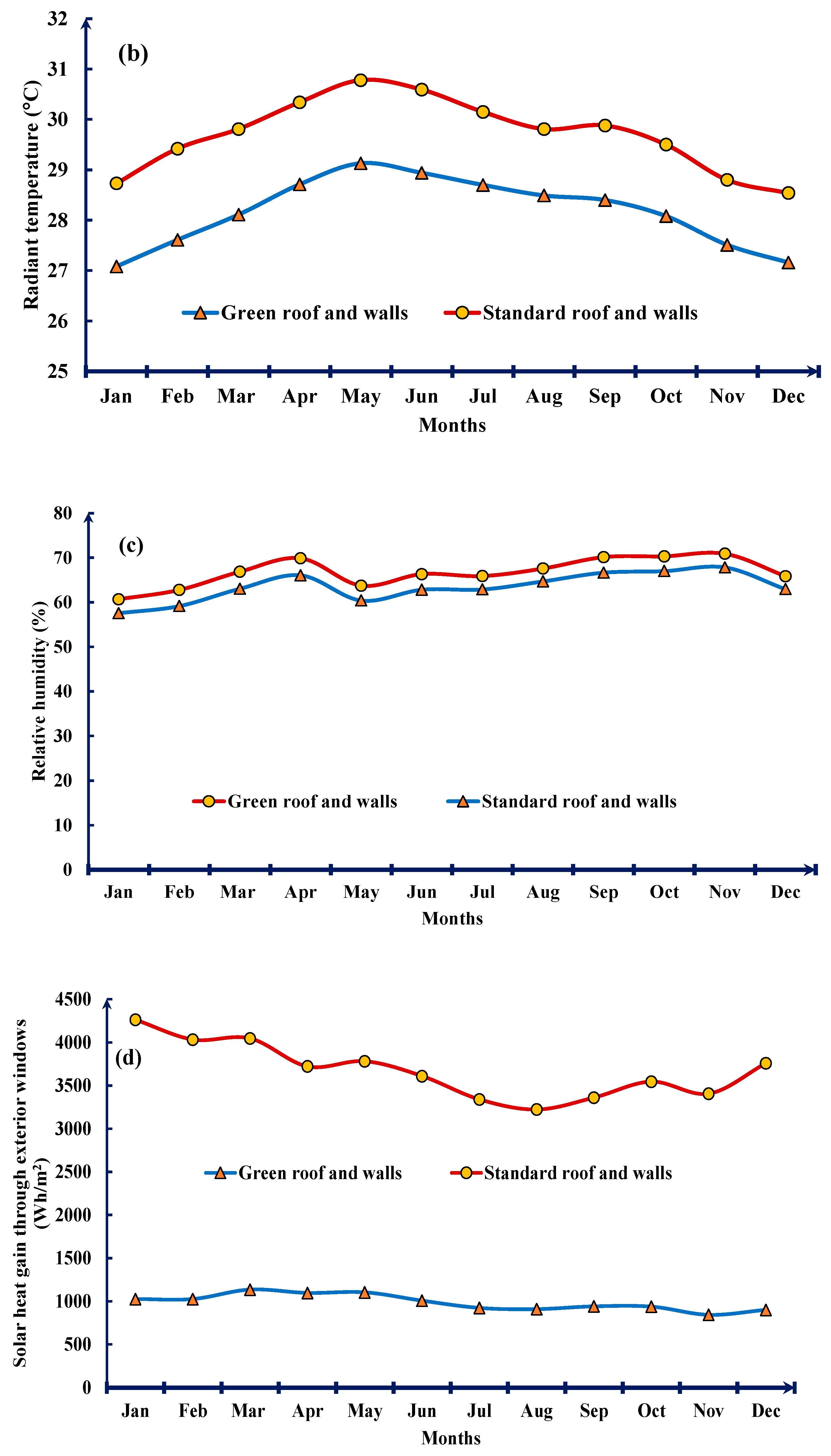
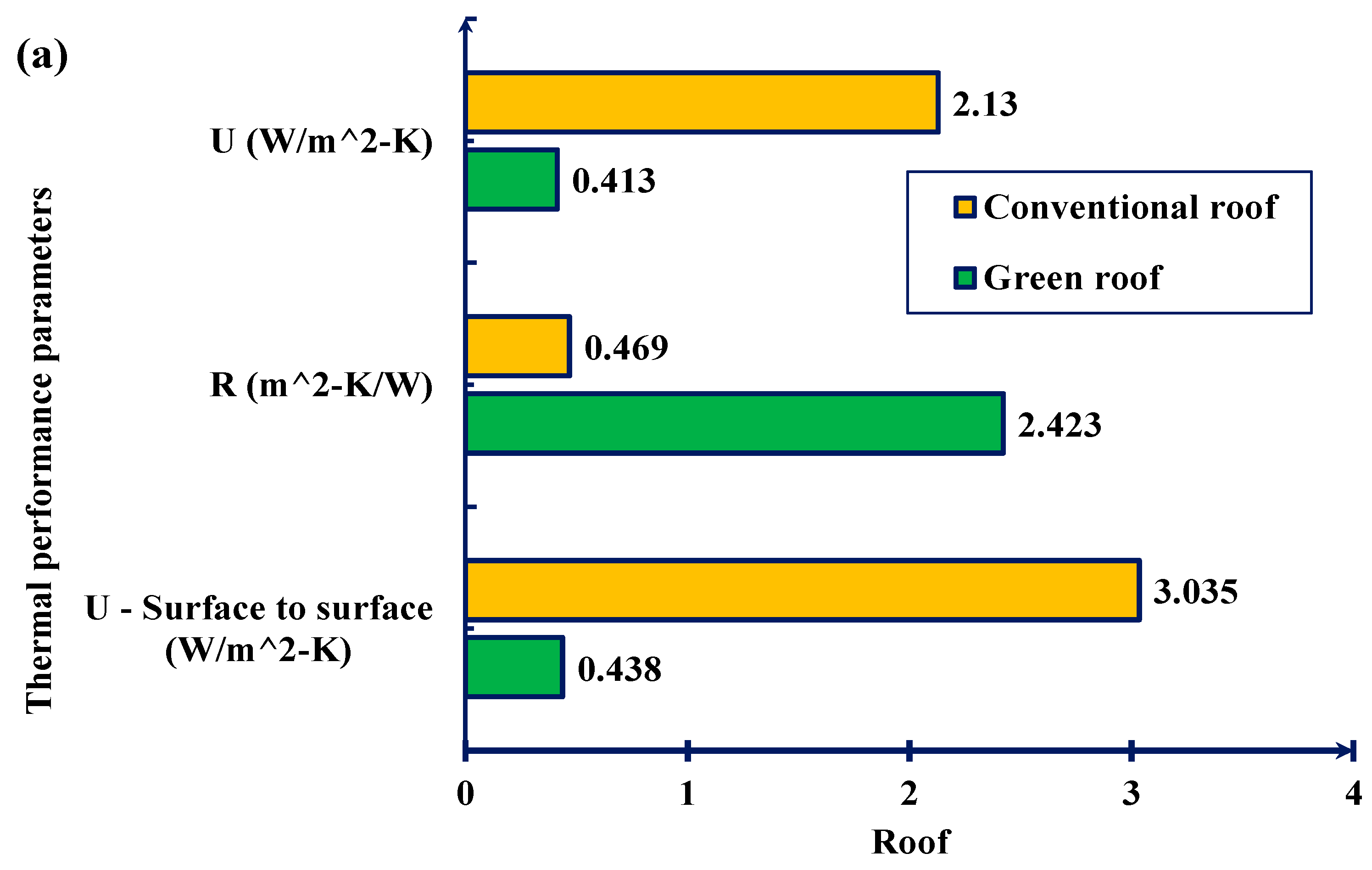
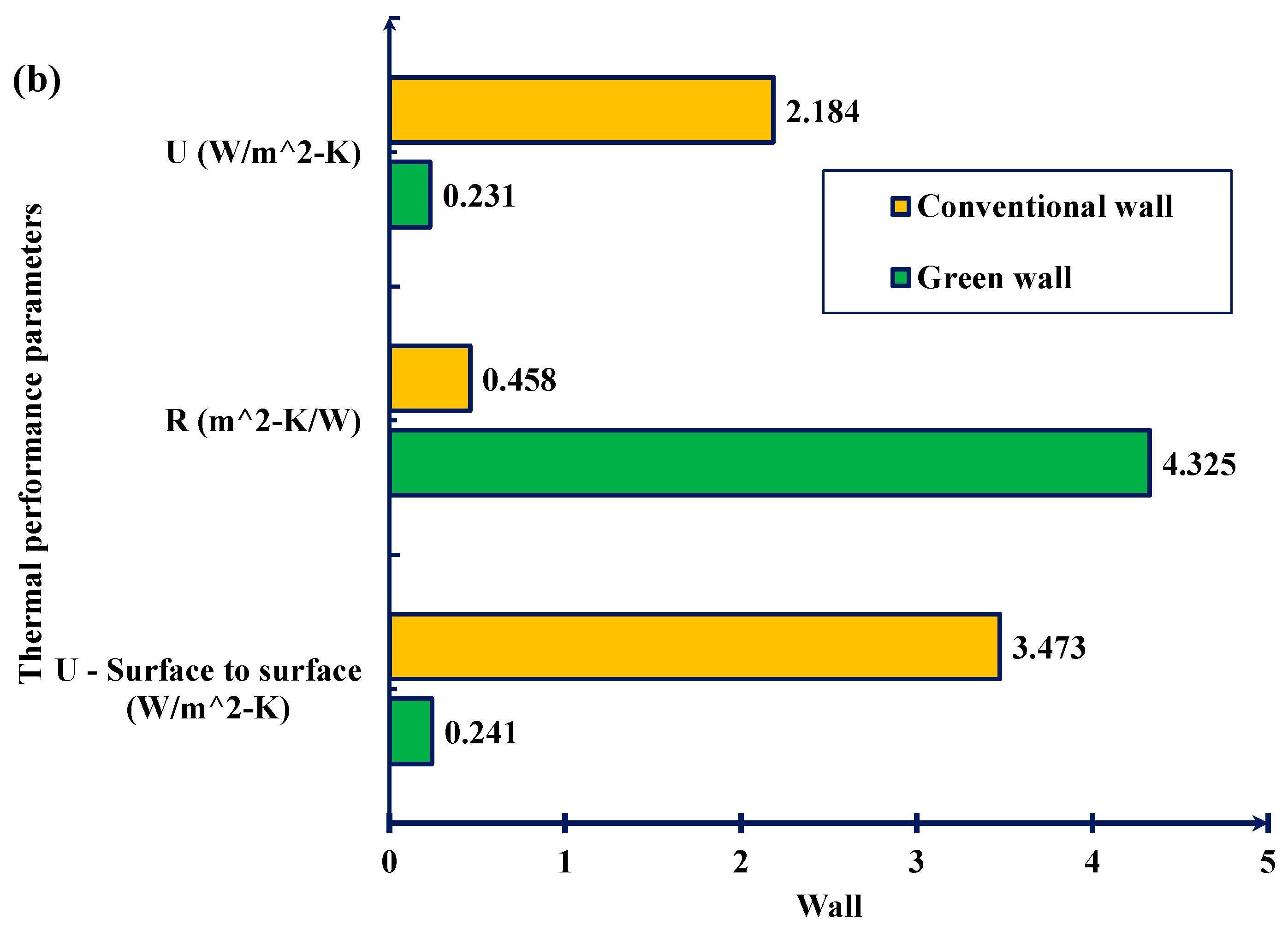
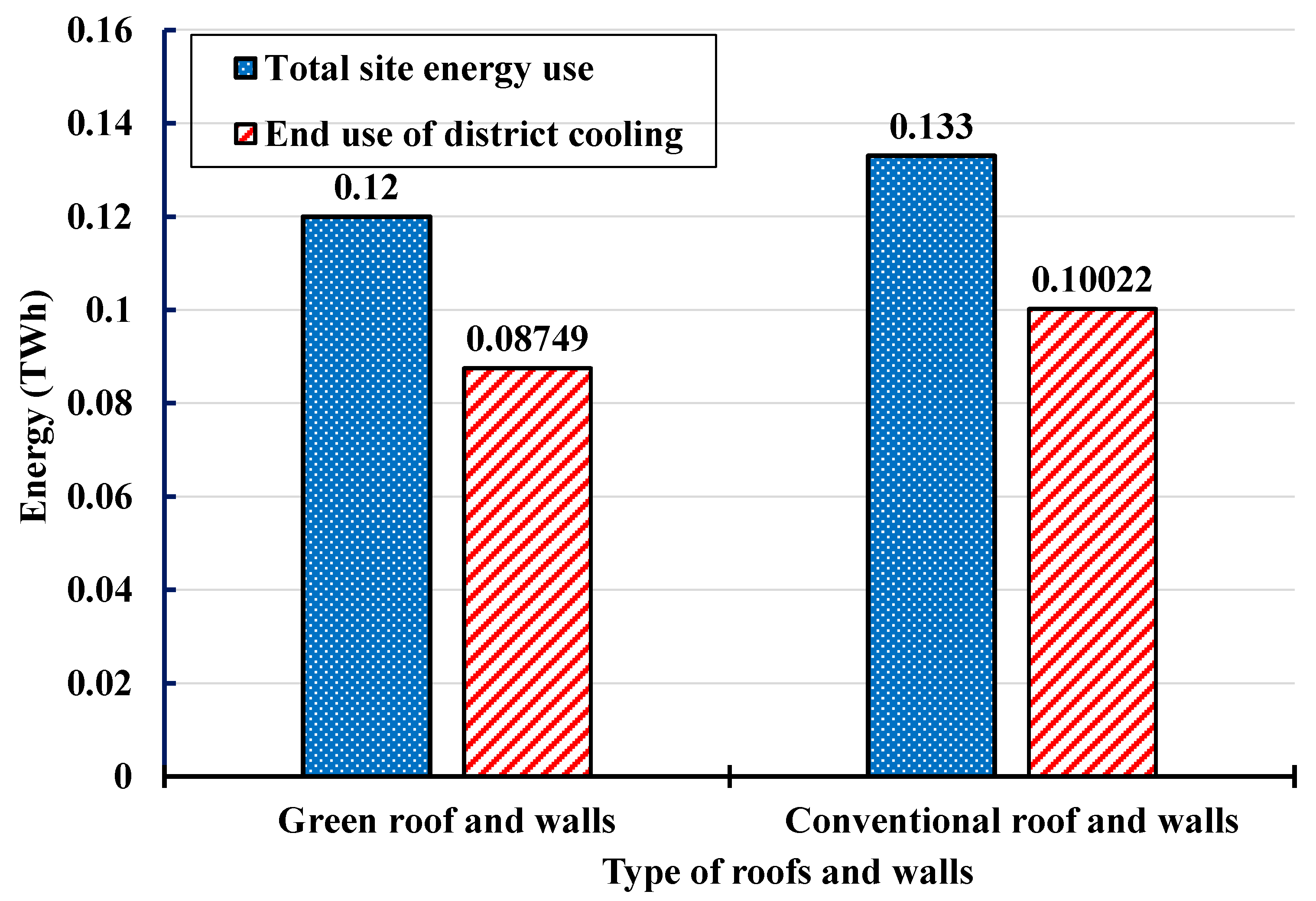
| Plant Materials Data | |
|---|---|
| Grass/straw materials—straw thatch (m) | 0.1 |
| Thermal bulk properties | |
| Conductivity (W/m·K) | 0.4 |
| Specific heat (J/kg·K) | 11 |
| Density (kg/m3) | 641 |
| Height of plants (m) | 0.6 |
| Green roof thermal parameters | |
| LAI | 2.7 |
| Leaf reflectivity | 0.22 |
| Leaf emissivity | 0.95 |
| Minimum stomatal resistance (s/m) | 180 |
| Max volumetric moisture content at saturation (%) | 0.5 |
| Min residual volumetric moisture content (%) | 0.01 |
| Initial volumetric moisture content (%) | 0.15 |
| Surface properties | |
| Thermal absorptance (emissivity) | 0.78 |
| Solar absorptance | 0.6 |
| Visible absorptance | 0.6 |
| Roof and walls | Jan | Feb | Mar | Apr | May | Jun | Jul | Aug | Sep | Oct | Nov | Dec |
|---|---|---|---|---|---|---|---|---|---|---|---|---|
| (a) Air temperature (°C) | ||||||||||||
| Green roof and walls | 23.55–26.95 | 24.28–27.28 | 24.74–28.04 | 24.79–27.99 | 25.58–29.20 | 25.52–29.3 | 25.13–28.73 | 25.1–28.5 | 25.09–28.29 | 24.62–27.92 | 24.17–27.37 | 23.79–26.99 |
| Standard roof and walls | 24.21–27.61 | 24.79–28.29 | 25.35–28.95 | 25.76–29.36 | 26.29–29.89 | 26.42–29.82 | 25.83–29.23 | 25.65–29.05 | 25.71–28.91 | 25.25–28.45 | 24.48–28.08 | 24.12–27.72 |
| (b) Radiant temperature (°C) | ||||||||||||
| Green roof and walls | 25.08–29.08 | 25.61–29.61 | 26.11–30.11 | 26.71–30.71 | 27.13–29.13 | 26.94–30.94 | 26.7–30.7 | 26.49–30.49 | 26.4–30.4 | 26.08–30.08 | 25.51–29.51 | 25.16–29.16 |
| Standard roof and walls | 26.73–30.73 | 27.42–31.42 | 27.81–31.81 | 28.04–32.34 | 28.78–30.78 | 28.59–32.59 | 28.15–32.15 | 27.81–31.81 | 27.88–31.88 | 27.5–31.5 | 26.8–30.8 | 26.54–30.54 |
| (c) Relative humidity (%) | ||||||||||||
| Green roof and walls | 57.67–63.67 | 60.76–62.76 | 63.84–69.84 | 66.86–72.86 | 60.72–66.72 | 63.31–69.31 | 62.88–68.88 | 64.56–70.56 | 67.11–73.11 | 67.31–73.31 | 68.87–72.87 | 62.85–68.85 |
| Standard roof and walls | 55.54–59.54 | 57.15–61.15 | 61.05–65.05 | 64.06–68.06 | 58.4–62.4 | 60.81–64.81 | 60.89–64.89 | 62.7–66.7 | 64.65–68.65 | 65.01–67.01 | 65.83–69.83 | 60.94–64.94 |
| (d) Solar heat gain through exterior windows (Wh/m2) | ||||||||||||
| Green roof and walls | 1017–1037 | 1016–1036 | 1125–1146 | 1087–1101 | 1094–1114 | 997–1017 | 913–933 | 900–918 | 932–952 | 930–940 | 834–854 | 890–910 |
| Standard roof and walls | 4232–4292 | 4001–4062 | 4035–4075 | 3701–3741 | 3781–3802 | 3590–3620 | 3329–3369 | 3203–3243 | 3340–3380 | 3525–3565 | 3385–3425 | 3733–3783 |
| Parameters | Wall | Roof |
|---|---|---|
| Inner surface | ||
| Convective heat transfer coefficient (W/m2·K) | 2.152 | 4.46 |
| Radiative heat transfer coefficient (W/m2·K) | 5.54 | 5.54 |
| Surface resistance (m2·K/W) | 0.13 | 0.1 |
| Outer surface | ||
| Convective heat transfer coefficient (W/m2·K) | 19.87 | 19.87 |
| Radiative heat transfer coefficient (W/m2·K) | 5.13 | 5.13 |
| Surface resistance (m2·K/W) | 0.04 | 0.04 |
| No bridging—conventional walls and roof | ||
| U-value surface to surface (W/m2·K) | 3.473 | 3.035 |
| R-value (m2·K/W) | 0.458 | 0.469 |
| U-value (W/m2·K) | 2.184 | 2.13 |
| No bridging—green walls and roof | ||
| U-value surface to surface (W/m2·K) | 0.241 | 0.438 |
| R-value (m2·K/W) | 4.325 | 2.423 |
| U-value (W/m2·K) | 0.231 | 0.413 |
Disclaimer/Publisher’s Note: The statements, opinions and data contained in all publications are solely those of the individual author(s) and contributor(s) and not of MDPI and/or the editor(s). MDPI and/or the editor(s) disclaim responsibility for any injury to people or property resulting from any ideas, methods, instructions or products referred to in the content. |
© 2023 by the authors. Licensee MDPI, Basel, Switzerland. This article is an open access article distributed under the terms and conditions of the Creative Commons Attribution (CC BY) license (https://creativecommons.org/licenses/by/4.0/).
Share and Cite
Pragati, S.; Shanthi Priya, R.; Pradeepa, C.; Senthil, R. Simulation of the Energy Performance of a Building with Green Roofs and Green Walls in a Tropical Climate. Sustainability 2023, 15, 2006. https://doi.org/10.3390/su15032006
Pragati S, Shanthi Priya R, Pradeepa C, Senthil R. Simulation of the Energy Performance of a Building with Green Roofs and Green Walls in a Tropical Climate. Sustainability. 2023; 15(3):2006. https://doi.org/10.3390/su15032006
Chicago/Turabian StylePragati, Saranathan, Radhakrishnan Shanthi Priya, Chandramouli Pradeepa, and Ramalingam Senthil. 2023. "Simulation of the Energy Performance of a Building with Green Roofs and Green Walls in a Tropical Climate" Sustainability 15, no. 3: 2006. https://doi.org/10.3390/su15032006






